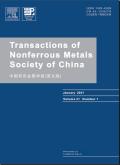(NH4)2V6O16·1.5H2O纳米带的制备及其在水铵离子电池中的应用
IF 4.7
1区 材料科学
Q1 METALLURGY & METALLURGICAL ENGINEERING
Transactions of Nonferrous Metals Society of China
Pub Date : 2025-04-01
DOI:10.1016/S1003-6326(24)66749-X
引用次数: 0
摘要
采用ph调节水热法制备了(NH4)2V6O16·1.5H2O (NVO)纳米带阴极,以构建高性能的水铵离子电池。在碳布上生长活性材料聚苯胺(PANI)制备阳极。组装的NVO//PANI电池在1.0 a /g电流密度下具有109.5 mA·h/g的可逆容量和23 W·h/kg的高能量密度。氨离子的插/萃取机制主要由赝电容行为决定。这些结果表明,NVO是一种潜在的候选水铵离子电池正极材料。本文章由计算机程序翻译,如有差异,请以英文原文为准。
Preparation of (NH4)2V6O16·1.5H2O nanoribbons and their application in aqueous ammonium-ion batteries
To construct high-performance aqueous ammonium-ion full batteries, (NH4)2V6O16·1.5H2O (NVO) nanoribbon cathodes were prepared by pH-regulated hydrothermal synthesis. Anodes were prepared by growing the active material polyaniline (PANI) on carbon cloth. The assembled NVO//PANI full cells exhibit a reversible capacity of 109.5 mA·h/g at a current density of 1.0 A/g and a high energy density of 23 W·h/kg. The ammonium-ion intercalation/extraction mechanism is primarily governed by the pseudocapacitance behavior. These results indicate that NVO is a potential candidate as a cathode material for aqueous ammonium-ion batteries.
求助全文
通过发布文献求助,成功后即可免费获取论文全文。
去求助
来源期刊
CiteScore
7.40
自引率
17.80%
发文量
8456
审稿时长
3.6 months
期刊介绍:
The Transactions of Nonferrous Metals Society of China (Trans. Nonferrous Met. Soc. China), founded in 1991 and sponsored by The Nonferrous Metals Society of China, is published monthly now and mainly contains reports of original research which reflect the new progresses in the field of nonferrous metals science and technology, including mineral processing, extraction metallurgy, metallic materials and heat treatments, metal working, physical metallurgy, powder metallurgy, with the emphasis on fundamental science. It is the unique preeminent publication in English for scientists, engineers, under/post-graduates on the field of nonferrous metals industry. This journal is covered by many famous abstract/index systems and databases such as SCI Expanded, Ei Compendex Plus, INSPEC, CA, METADEX, AJ and JICST.

 求助内容:
求助内容: 应助结果提醒方式:
应助结果提醒方式:


